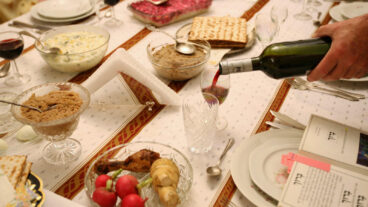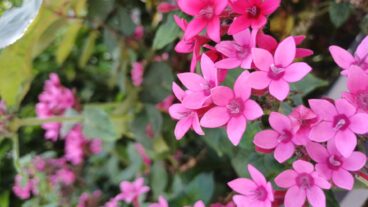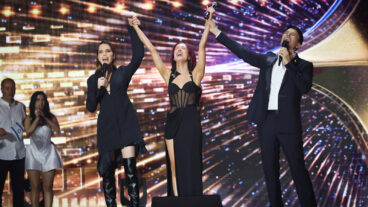Initiated by child Holocaust survivor Dr. Kitty O. Cohen, the Painting Pain, Dreaming Peace program led Palestinian and Israeli children, ages 9-12, to express pain, fear and anger through painting.A group of 150 Palestinian and Israeli schoolchildren unveiled last week its version of a new reality in Jerusalem. Weary of violence, they crafted on paper a world where bullets are made of chocolate, flowers grow from fists, and loud noises that go bang in the night are just fireworks of joy.
The reflections of optimism are the outcrop of a two-year series of workshops for the children of Jerusalem, called Painting Pain, Dreaming Peace.
Initiated by child Holocaust survivor Dr. Kitty O. Cohen in response to the intifada, the program led Palestinian and Israeli children, ages 9-12, to first work in their own communities to express pain, fear and anger through painting.
During the initial leg of the program, the Palestinian youngsters created such words as ‘We are not Caged Animals,’ ‘Cerfew,’ ‘Pain and Fear,’ ‘Shelling,’ and ‘The Old City in Mourning.’
“We worked during hard times, violent times, quiet times. It gave the children a good feeling,” said Palestinian art teacher Issam Sabbah.
The Israelis, on their side of town, similarly painted ‘Bombs in City Center,’ ‘My Pain,’ ‘A Country in Pain,’ ‘A River of Tears,’ ‘We Became Rough,’ ‘Escape to a Peaceful Place,’ and ‘Jerusalem is so Sad.’
Later, the Israel and Palestinian children joined together for a second series of individual and joint projects that looked at their shared feeling and experiences of mourning and fear, and then to their hopes for the future. Their final paintings were liberally scattered with symbols of unity, partnership and serenity.
One hundred of their paintings from the last two years, selected from among hundreds, are now on exhibit through at least March 4 at Jerusalem City Hall.
“We learned to work together; it was fun,” said Muhammed Al-Khatib, 12, who, like his classmates, had never previously met a Jewish-Israeli peer. Smiling uncontrollably in his oversized sweater at the opening, he pointed out his contribution to the exhibit, a drawing called ‘The Wall That Separates Us.’
“We want peace,” said Reem Al-Halawani, 11, another Palestinian student, with her two little brothers in tow, explaining that the workshops seemed like any normal situation of kids playing together. “We painted, we talked, we played.”
Among the many optimistic paintings she made, She drew her vision of springtime, with Israeli and Palestinian flags shaped like hearts, side-by-side, with flowers and butterflies swarming around them.
“I am happy to see that the children found something hopeful to paint from within their pain,” one Israeli parent said at last week’s opening at City Hall.
The Jerusalem Municipality partnered with Cohen and her Institute for the Study of Religions and Communities in Israel to sponsor the project and exhibit. The Municipality’s East Jerusalem Department of Social Affairs recruited the Palestinian children and teachers, with support from the Jerusalem Foundation, an Israeli NGO.
The children rated the program as successful though there were logistic problems. Israeli children did not receive security permits to travel to east Jerusalem. And the students and most of the parents do not share any common language, save a few words here and there.
But even that language was rated as the most difficult challenge, youngsters from both sides said they were able to communicate through shared activities and with a little help from translators.
Bar Ama, 12, said meeting Palestinian children for the first time was different than she expected. “From the first meeting it was very nice. It was fun to work with them. I discovered they are good.”
“They are human – each one is a person unto himself,” said Israeli student, Lior Yochanan, 11.
Palestinian mothers in traditional dress stood together with Israeli parents, as their children took them on a tour of their creations. City Hall, an Israeli municipal government facility on the seam of west Jerusalem, is frequented daily by scores of Israelis and Palestinians. The exhibition and its catalogue are translated in Hebrew, Arabic and English
Bianco Sanc, 11, an Israeli 6th grader who participated in the project for one year, didn’t see anything unusual about Israeli and Palestinian children looking at each other’s portraits of pain and hope.
He raised his eyebrows and shrugged: “There is nothing like simple children.”
The Jerusalem Municipality is considering extending the exhibition, before it travels around Israel and abroad. Curators at the US Congress facility in Washington have also expressed interest in hanging the exhibition, organizers say.












